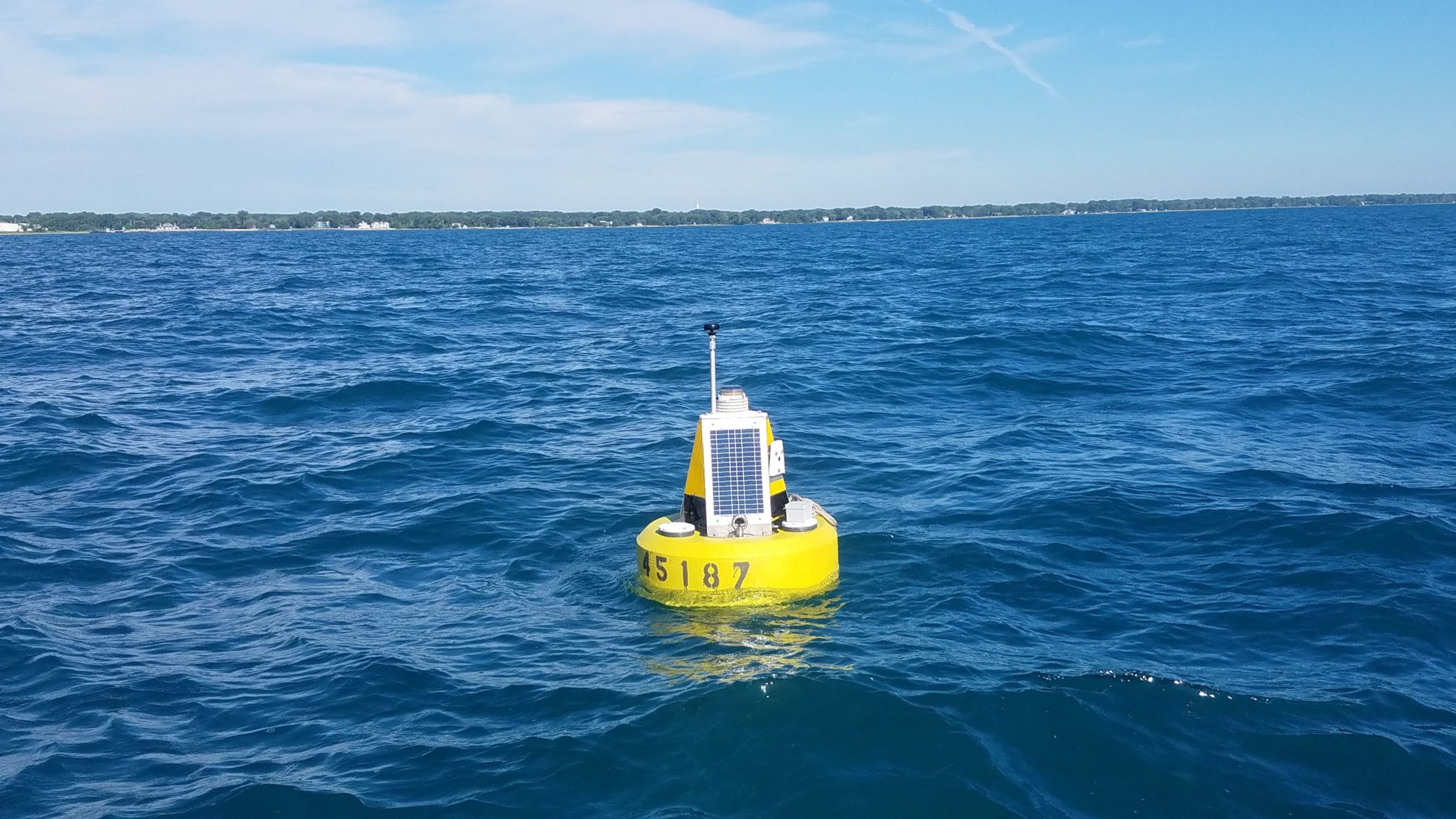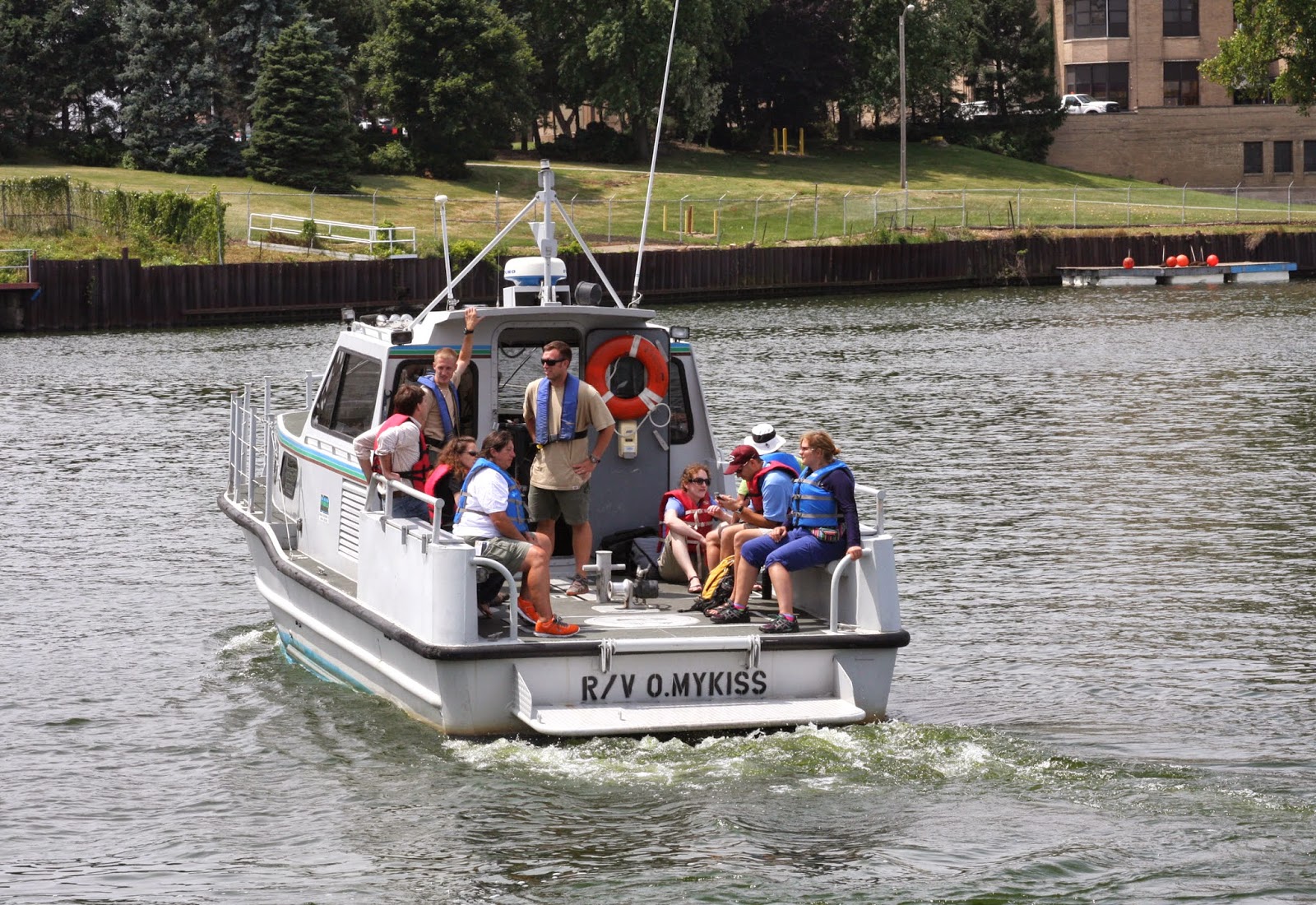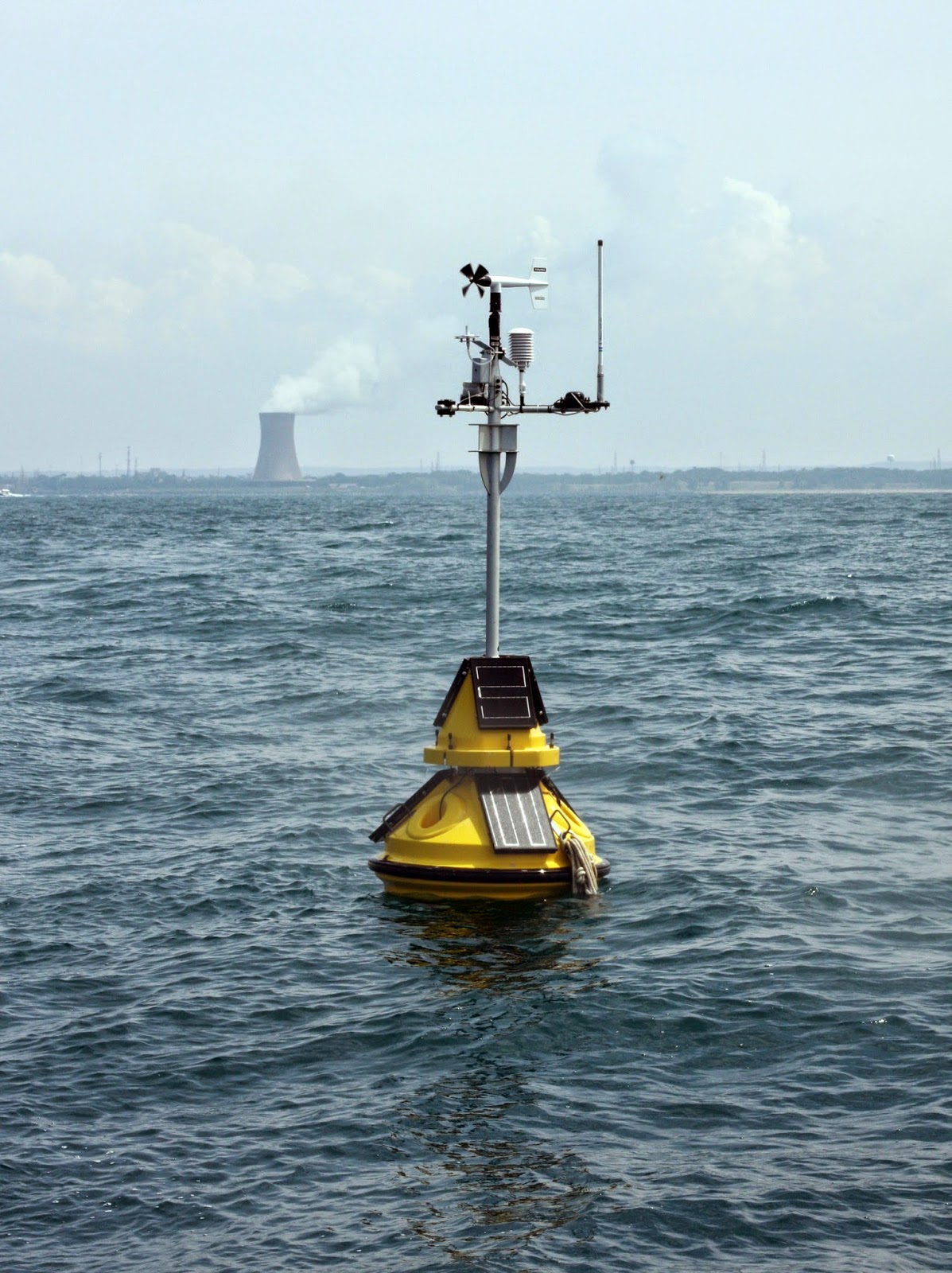Lake Michigan now has two new buoys that monitor lake conditions in real-time. Placed about a mile offshore in Illinois waters—close to Waukegan and Winthrop Harbor—each buoy will measure air and water temperatures, wave and wind conditions, and water currents every 20 minutes while deployed. The buoys are also equipped with webcams that transmit an image and video once per hour during daylight hours. Illinois-Indiana Sea Grant will host the most recent data and images on their program website, while data will be managed by Great Lakes Observing System (GLOS).
Ethan Theuerkauf and colleagues from the Illinois State Geological Survey (Prairie Research Institute, University of Illinois at Urbana-Champaign) and the Illinois Department of Natural Resources Coastal Management Program have been working to deploy these buoys for several years. “We plan to use the buoy data to study the drivers of erosion along the Illinois shoreline,” said Theuerkauf, a scientist with the Illinois State Geological Survey and an adjunct professor at the University of Illinois at Chicago. “It is a bonus that so many boaters and swimmers can also use the information.”
“It’s great to have two more systems that will help scientists and weather forecasters understand what’s happening in the Illinois and Indiana waters of Lake Michigan,” said Jay Beugly, an aquatic ecology specialist with Illinois-Indiana Sea Grant, who helped place the buoys in the water on July 19 and is the main support for the Illinois-Indiana Sea Grant real-time buoy program.

Photo credit: Ed Verhamme, LimnoTech, Inc.
Ed Verhamme, a project engineer with LimnoTech, Inc., designed and custom-built these buoys for application along the Illinois shoreline. “These buoys are closer to shore than other buoys in Lake Michigan, which helps scientists better understand how waves and currents affect the shoreline, but also required us to use a different type of buoy”, said Verhamme who also joined Beugly and Theuerkauf during the buoy deployment.
As of July 23, 2018, data from the two new buoys can be found via the GLOS data portal and the National Data Buoy Center by searching buoy numbers 45186 (Waukegan) and 45187 (Winthrop Harbor). These buoys were supported by a NOAA Coastal Zone Management Projects of Special Merit Grant.
Contact: Ethan Theuerkauf ejtheu@illinois.edu, Ed Verhamme everhamme@limno.com, Jay Beugly jbeugly@purdue.edu
 Fourteen teachers from Illinois and Indiana are hard at work developing new science lessons that incorporate real-time data from the Michigan City buoy after a training workshop held last week at Purdue North Central.
Fourteen teachers from Illinois and Indiana are hard at work developing new science lessons that incorporate real-time data from the Michigan City buoy after a training workshop held last week at Purdue North Central.
During the day-long workshop, IISG’s education and research teams, along with Purdue University’s Cary Troy
, introduced teachers to the environmental monitoring buoy, the data it collects, and how researchers are using the data to better understand the nearshore waters of Lake Michigan.
 The highlight of the workshop for many was the boat ride four miles into Lake Michigan to see the buoy first-hand—in smaller groups due to the size of the boat. The trips also gave teachers the opportunity to talk more with researchers and staff from the Indiana Department of Natural Resources(DNR) about the buoy and other data collection methods used to monitor fisheries, understand lake dynamics, and improve water safety.
The highlight of the workshop for many was the boat ride four miles into Lake Michigan to see the buoy first-hand—in smaller groups due to the size of the boat. The trips also gave teachers the opportunity to talk more with researchers and staff from the Indiana Department of Natural Resources(DNR) about the buoy and other data collection methods used to monitor fisheries, understand lake dynamics, and improve water safety.
The teachers will work together to develop at least six curriculum activities that improve STEM education—science, technology, engineering, and math—and boost understanding of Great Lakes issues. These won’t be complete till early next year, but the teachers already have big ideas for how to integrate the buoy data into their classrooms.
Several hope to use information on wind speed and water currents to improve their weather units. Others plan to use data collected by the buoy’s thermistor chain, which measures temperatures at different depths, to pinpoint the likely habitats of specific fish species and determine whether invaders like Asian carp could make a home in Lake Michigan. Some even expressed interest in having students compare buoy data with environmental characteristics collected on land to better understand solar radiation and seasonal changes.
The final lesson plans will be available on the IISG website.
Funding for the workshop was provided in part by the Indiana DNR Lake Michigan Coastal Program. Special thanks to the DNR staff at the Michigan City field office for taking the participants out on the lake.
The Michigan City real-time monitoring buoy, jointly owned and operated by Illinois-Indiana Sea Grant and the Purdue University Department of Civil Engineering, is out of the water for the 2013 season. This year, the buoy was deployed for 154 days, reporting data every 10 minutes around-the-clock. Over 3,400 people visited the buoy website during deployment, with an average of 18 hits per day. As one user put it, “Many, many of us have found the information as nothing less than terrific! Sailors like myself, fisherman like my dock neighbor, and so many pleasure boaters from Michigan City, Burns Harbor like to know what to expect once we leave the harbors.”
Buoy-watchers will have more to look forward to in 2014, as this winter the buoy will be getting an upgrade. Thanks in part to a grant from the Indiana Department of Natural Resources Lake Michigan Coastal Program awarded to IISG’s Tomas Hӧӧk, the buoy will broadcast real-time temperatures at different depths during the 2014 season and beyond. The buoy has always collected surface water temperature, but now it will also collect temperatures approximately every three feet from the surface to the bottom of the lake.
“We are very excited to install this chain of temperature loggers”, said Carolyn Foley, IISG assistant research coordinator who will help implement the new chain. “A number of groups told us they would use this information, from kayakers wanting to know if it’s warm enough to go for a paddle to anglers wanting to know where the best fishing will be.”
In addition to installing the new temperature loggers, IISG education staffers Terri Hallesy and Robin Goettel will work with Indiana educators to develop data-based lesson plans. IISG outreach staff, including Angela Archer and Leslie Dorworth, will also attend at least one outdoor show in northwestern Indiana to get direct feedback on ways to improve the buoy website for future seasons.
We would like to hear from anyone who uses the buoy data, particularly anglers, paddlers, and others who use southern Lake Michigan for recreation, as well as educators interested in using buoy data in their classrooms. If you 1) are an educator in grades 8-12 interested in participating in a workshop to acquire data sets for teaching and to develop lesson plans with buoy data, 2) have feedback related to improving the buoy website, and/or 3) would like to suggest an outdoor show for us to attend, please send us an email (iisg@purdue.edu) with “Buoy feedback” in the subject line. We expect to redeploy buoy in mid-May 2014.
Special thanks to the staff of the Indiana DNR Michigan City Field Office for their help deploying and retrieving the buoy.



